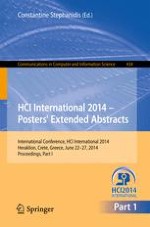This is the first of a two-volume set (CCIS 434 and CCIS 435) that constitutes the extended abstracts of the posters presented during the 16th International Conference on Human-Computer Interaction, HCII 2014, held in Heraklion, Crete, Greece in June 2014, and consisting of 14 thematic conferences. The total of 1476 papers and 220 posters presented at the HCII 2014 conferences were carefully reviewed and selected from 4766 submissions. These papers address the latest research and development efforts and highlight the human aspects of design and use of computing systems. The papers accepted for presentation thoroughly cover the entire field of Human-Computer Interaction, addressing major advances in knowledge and effective use of computers in a variety of application areas. The extended abstracts were carefully reviewed and selected for inclusion in this two-volume set. This volume contains posters’ extended abstracts addressing the following major topics: design methods, techniques and knowledge; the design of everyday things; interacting with information and knowledge; cognitive, perceptual and emotional issues in HCI; multimodal and natural interaction; algorithms and machine learning methods in HCI; virtual and augmented environments.
